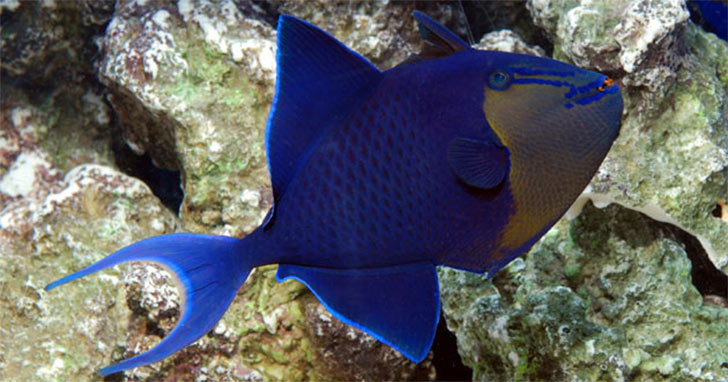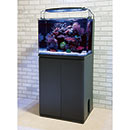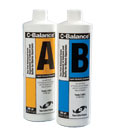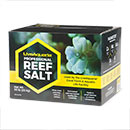
The natural beauty of a marine aquarium is highly desired and admired. But what is involved in properly setting up a saltwater aquarium? There are different types of saltwater setups, some are easier to maintain while others require more effort. Before you dive into saltwater aquariums, find out what differentiates these aquariums and why certain marine aquariums are more challenging than others.
FISH-ONLY MARINE AQUARIUMS
Saltwater aquariums can be grouped into three basic types – fish-only aquariums, fish-only-with-live-rock aquariums, and reef aquariums. Among these three types, the most basic marine setup is the fish-only (FO) aquarium.
Fish-only aquariums, as their name implies, are designed to house and showcase marine fish. Since the fish are the center of attention, FO aquariums are sparsely decorated, often with coral skeletons or coral replicas. Like any aquarium setup, maintaining proper water parameters and employing efficient filtration is key. The availability of beautiful and hardy marine fish such as damselfish, yellow tangs, and captive-bred species adds to the success of FO aquariums. The fish-only aquarium is a great setup for the dedicated beginner interested in marine aquariums. This saltwater setup allows novice hobbyists to "get their feet wet" and become familiar with equipment, water parameters, fish, and the maintenance of marine aquariums.
FOWLR AQUARIUMS (Fish-only-with-live-rock)
Fish-only-with-live-rock (FOWLR) aquariums can be described as a blend or a stepping stone that bridges FO aquariums and reef aquariums. While marine fish are still the focus of FOWLR aquariums, basic elements of the reef aquarium are introduced – most notably, live rock. Live rock is fragmented pieces of biologically-active calcium-based "rock" naturally colonized by a variety of marine life including invertebrates, sponges, and millions of beneficial nitrifying bacteria. This rock, teeming with beneficial life, provides excellent supplemental filtration and helps maintain stable water parameters. Live rock adds a new dimension to the aesthetics and care to the basic marine aquarium. Special considerations for FOWLR setups include proper curing or acclimation of reef rock, additional light or supplements to cultivate desirable coralline algae, and the restriction of many medications that harm beneficial life found in reef rock.
REEF MARINE AQUARIUMS
The most challenging and expensive of the marine aquariums, reef aquariums are stocked primarily with corals and other invertebrates, with little or no fish. The corals and invertebrates are the stars of a reef aquarium. Since marine invertebrates are very sensitive to water conditions, water parameters must be monitored on a regular basis to maintain pristine conditions. Also, many corals are photosynthetic and require proper lighting to survive. The inhabitants of reef aquariums require special attention, so it is crucial to research lighting, water movement, supplementation, and other requirements.
TIPS FOR SALTWATER AQUARIUM SUCCESS
- Learn as much as you can about the individual fish and invertebrates that interest you.
- Choose fish and invertebrates suitable for your experience level. Avoid difficult-to-care-for species with poor success rates in captivity.
- Supplement filtration with a protein skimmer to ensure excellent water quality.
- Practice patience. Proceed slowly to ensure stable water parameters. Stock your aquarium gradually over a period of a few months.
| WATER PARAMETERS |
| Parameter |
Suggested Level FO |
Suggested Level FOWLR |
Suggested Level Reef |
| Specific Gravity |
1.020-1.025 |
1.020-1.025 |
1.023-1.025 |
| Temperature |
72-78°F |
72-78°F |
72-78°F |
| pH |
8.1-8.4 |
8.1-8.4 |
8.1-8.4 |
| Alkalinity |
8-12 dKH |
8-12 dKH |
8-12 dKH |
| Ammonia (NH3) |
Undetectable |
Undetectable |
Undetectable |
| Nitrite (NO2) |
Undetectable |
Undetectable |
Undetectable |
| Nitrate – Nitrogen (NO3) |
< 30.0 ppm |
< 30.0 ppm |
< 1.0 ppm |
| Phosphate (PO4) |
< 1.0 ppm |
< 1.0 ppm |
< 0.2 ppm |
| Calcium |
350-450 ppm |
350-450 ppm |
350-450 ppm |
| Magnesium |
1150-1350 ppm |
1150-1350 ppm |
1250-1350 ppm |
| Iodine |
0.04-0.10 ppm |
0.04-0.10 ppm |
0.06-0.10 ppm |
| Strontium |
4-10 ppm |
4-10 ppm |
8-14 ppm |
Recommended Products
|






